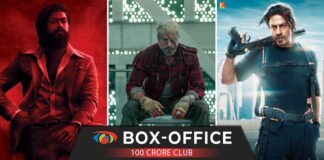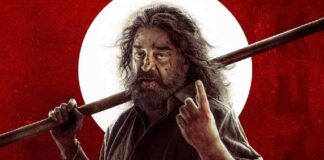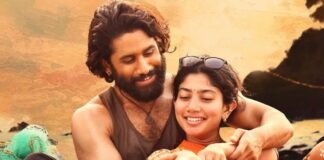
Ra.One director Anubhav Sinha writes exclusively for Koimoi.com on the making of his magnum opus:
Just when I thought, all the difficult parts of making Ra.One were over, Komal (Koimoi.com Editor Komal Nahta) called. “Anubhav, will you please write an article about how difficult it is to make such a technologically advanced film in India?” The real difficulty now is, where do I start. I guess, at the start.
Since traditionally, we do not make many ‘technologically advanced’ films, our minds are not tuned or trained to conceiving such stories. We think, ‘they’ make such films. I guess my background, as an engineer must have made me more flirtatious with technology. Earlier in the past, Shekhar Kapur (Mr. India), Mr. Rakesh Roshan (Koi… Mil Gaya and Krrish), Goldie Behl (Drona) and Sujoy Ghosh (Aladin) must have had their own reasons to have dabbled in this beautiful relationship between Cinema and Technology. The conception of Ra.One in my mind was a chance that I will always thank God for. This chance transported me into another world. Getting in, I agree, was tough but it is so wonderful here.
Shah Rukh Khan – The Power & Vision

So the next step, after having conceived, is to find some one to back such an idea. Such ideas, like I said, are rarely executed in our business. Some of them do fail and unfortunately those become the ones to be quoted as examples. The successful ones are termed as rare cases. Just as an example, if a director today tried to sell an English-language Bollywood film, citing the success of Delhi Belly, the example may not be entertained. They will credit the success of Delhi Belly to the producer’s star power. So it will take a lot more successful English-language Bollywood films before the investors accept that to be a good business model too. To make matters worse, VFx films are perceived to be far more expensive than any other genre. I am in no way implying that VFx is not expensive, but the point that I am trying to make is that we do, on the other hand, spend such amounts or more, on other elements of a film that can fail too. Like stars, sets, songs, shooting etc. But those are known elements that can fail. VFx is an unknown element that can fail. That probably is the only difference. The other difference in favour of VFx films is that the top five grossing films in the world are VFx films. I was fortunate to have met SRK, a man who had both, the power and the vision. But to tell you the truth, I have, in the recent past, been running into the believers of VFx more often than ever before. I don’t deny that this could be a Ra.One effect.
So once the idea is conceived and invested in, starts the execution. The key elements that I learnt executing a VFx film are Team, Discipline, Planning, Precision, Sharing Information, and, above all, PATIENCE.
Importing The Team
Over 15 years of directing has taught me something special. A good team has a very interesting character, if they find a good captain; they generate a capability to become better than the captain himself. Then the captain has to work harder than the team to always deserve the chair he is in and this process goes on. I was fortunate, I had one such team. You MUST love and respect the very concept of a Team. The goal finds the team first and then the team finds the goal. This was the toughest part while making Ra.One. I had to build a team to do something that had not been done before in India. Not to this extent, for sure. Outside India, there was a large number of people to chose from but it was not a good idea, for a variety of reasons, to import the entire team. I chose to import some key players who had ample experience on films like these. DoP Nicola Pecorini, VFx Supervisor Jeffery Kleiser, Stunt Co-coordinators Andy Gill and Spiro Razatos. It was obvious that they would bring in some more assistants with them. The idea was to create a mix of some imported experienced members and some home-grown bundles of talent and passion. This sounded like a good plan and eventually turned out to be one too. But there was a brief (or may be a little more than that) period of teething problems. These people came from different work cultures, and social milieus. I am not even mentioning languages and nomenclature. But soon, we all realised that the goal was one. Synergy followed and we ended up being the most unprecedented team working relentlessly towards the goal. Like I said earlier, the goal finds the team first and then the team finds the goal.
Bollywood Lacks Discipline
Once the team was in place, the next task was to find the right discipline. I must admit, Bollywood does not have the most disciplined work culture, especially when we look at it from the global perspective. And I am not talking about reporting or departing on time here or even respecting the ones who must be respected. I am talking about meticulous planning. Our shooting schedules are as disciplined as they can get, given the pre-production planning we do, or the lack of it. Films like these MUST be pre-produced to the minutest detail. The Indian team was aware of it and was willing to go to any lengths to make the pre-production work. The ‘imported crew’ came with the ‘method’ they have evolved over years making such films. I am happy, our team caught up and learnt. Story-boards were made. Really tough sequences were turned into animatics. In the pre-production meeting, each department would go over each and every shot and discuss how to execute it. Every department would come up with the problems they might face and the whole team would put their heads together to figure out how to go about solving the problems. Then, these plans would be improvised when the entire team visited the actual location, considering the challenges that the physical location would offer. After all this, we would be 80% ready for the execution. Save 20% for the last-minute improvisations. For example, we needed a freshly paved road next to a very peculiar structure… We would either find a suitable structure or a freshly paved road. Never together. Finally, we settled for paving our own road next to a structure we liked. It turned out awesome but had the planning not gone into it, it could have just remained an attempt.
Discipline does not lead to instant gratification. You must remain constantly disciplined for it to bear fruit for you. You may not find instant result in reporting on set on time one day. You have to repeatedly do it to observe how the whole team adapts to this discipline and more. This is a very small example. The whole process of making movies may appear to be madness from outside but there is a method to this madness. More technologically advanced the film, more method to the madness. More method will need more discipline and more discipline will mean more fruits. This is a constant process. The discipline HAD TO BE followed even at the cost of sounding too rigid. For every shot in the car chase, there would be a half-speed rehearsal. Half speed wouldn’t necessarily mean mathematically half, but at a really slow speed. Every player of the shot got to see what was going to take place at a high speed. Every player got to prepare for safety and perfection. In that order. This is a method and must be followed. On one occasion, we just drifted past the method and witnessed an unplanned crash. Such films MUST BE executed with discipline or else you may not get the desired results or may get some undesired results. We, as a society, are not great believers of discipline and this is an area we need to learn heavily, should we consider to continue making such technologically advanced films.
Precision Is A Habit
The next chapter in making such films is Precision. The German precision, to be precise – whether it is precision in planning or executing. Sometimes, such precision seems unnecessary and sometimes, it actually is. But precision is a habit. You either have it or you don’t. At the prep visit to the car chase location, we had Andy, our stunt coordinator, and his team measuring every nook and corner of the road. Including the height of the bridge above the road or even those we thought he did not need. Of course, it took a little longer than the rest of the departments. Days later, in the pre-production meeting, all the heads of departments were discussing the execution in great detail. Most of us realised that some departments did need those measurements that seemed unnecessary the other day. The fact that we had those measurements made the whole execution simpler and safer. Not to mention that we saved at least one more visit to the location. And precision is not only about measuring meters and inches. It is also about measuring resources and capabilities because one mistake in one measurement will have a domino effect. So the next time you say, “Let’s meet at 4 or 5”, try and say, “Let’s meet at 4.35. This habit MUST be cultivated. The next step, of course, would be to get there at 4.35.
Why Sharing Information Is Important
Sharing of information is the next best thing you can do. Like they say, there is no such thing as over-information. Under-informed, you are susceptible to mistakes. Over-informed, you are just over-informed.
Let us see what a film is. It is a story that a Director ‘sees’ in his head. He doesn’t necessarily write it, but he ‘sees’ it first. He wants to visually share the story with the world. Mind you, it is still in his head. He collaborates with a set of artistes and seeks their help to bring this story to life. These artistes are Actors, Camerapersons, Costume Designers, Art Directors, Editors, Music Composers etc. The flow of information begins here. The Director tries to tell the story, as he sees it, to these collaborators who will, in turn, play their parts and put all the pieces together to convert it into a visual story. The good news and the bad news is that the performances of all these artistes depend on each other. So they must share their ideas (read information) with each other. In the beginning, it is all very intangible and requires them all to be in complete tandem until the visual begins to take shape in the same manner that the Director had envisioned.
As if this was not intangible enough, they started making movies with visual effects. On a bad day, trust me, there can be a situation that the actor is standing on a five feet high blue platform against a massive blue backdrop, holding a tight rope tied to a 30 ft. high catwalk. Several fans blowing full blast on him while seven cameras surround him. Five whiz kids sit or stand next to seven monitors frantically discussing something in whispers while an assistant makes some marks on three monitors with a white pencil. He appears to be trying to do something really precise, while the whizkids, too, take him damn seriously. The DoP yells, ‘little right…. little right…. no.. the other right… yeah…. look in that direction…. the wave is coming from there.’ Sounds funny? Confusing? For them, it is not… The man will finally appear to be standing on a sailboat in the middle of a storm trying to steer the boat. The good news will be that each and every one knows everything about the shot that is being done. Because, they shared information. In a film like this… you don’t share information, you don’t make the movie. Or you kill your Producer. Or you grow old.
Terry Bamber, my first Aide, from London, taught us a wonderful thing. He would write a diary every single day and that would be circulated among the whole team. Even during prep, Terry would relentlessly send us that diary. He would write every single piece of information that he would gather during the day. It could be as important as “The grip equipment is stuck with the customs” or as useless as “The flush in the first floor toilet will be repaired tomorrow”. No, seriously. That could be important information for someone. You cannot decide what is useful information for me. You can only decide that it is information, and then you share it. Simple.
Four Years For One Shot!

You want to make a visual effects movie and you don’t have patience. You better be in some other business. That man on the blue platform will remain on the blue platform for the next three months until the wireframe of the sailboat is ready. Then he will stand on the static wireframe for a few weeks until the ocean is simulated. Then the wind effect on the water and the same on the actor will not match. Two weeks later, the wind will be fine on both but the lighting may not be fine. It will be quite a while before he will stand on the sailboat on a stormy night, steering his way to the island where his ladylove is stranded. I had been longing to see one shot of Ra.One that I shot eight months back. Not to mention, I ‘saw’ it four years back. I was now dying to see it and they were dying making it. I saw it on 15th October. Just eleven days before the release! My heart sank. It wasn’t as good as I had imagined it to be. The VFx team has gone into overdrive to make corrections. That is the last shot that will go into the movie. That was the shot I have been dying to see. I am waiting patiently to see it, because, I believe, it will become what I want it to be. Because I believe, the team that delivered every single shot to my satisfaction will eventually deliver this one too. I am waiting patiently or else my next best option is medical attention. So PATIENCE is a key word that you must learn if you want to make a visual effects film.
It has been five years of relentless belief. It has been five years of relentless support from my Producer and the whole team. There must be something right I did to earn this. I don’t know what that was. Will let you know as soon as I figure out. Until then… I shall wait for that beautiful shot my VFx team is making for me.



 Follow Us
Follow Us









